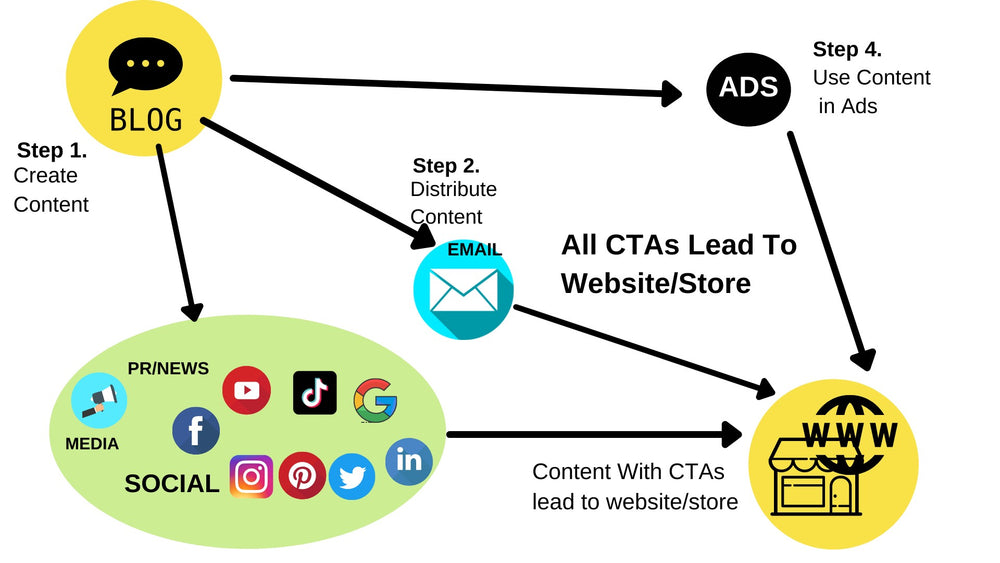10 consejos sobre cómo reutilizar tu blog con herramientas

Escribir un blog es un trabajo arduo... debe generar ideas y encontrar imágenes, y ahora Google quiere más recursos visuales en nuestro contenido en línea para mejorar el viaje del cliente en nuestros sitios web.
CONSEJO DE LA SEMANA!
Vale, hay más de un consejo...
Cómo reutilizar el contenido de tu blog -
1. Crear un blog con un mínimo de 5 pasos, formas o consejos (lista), y más es una gran idea.
2. Agregue solo 1 video a su blog: mantiene a los visitantes en mi sitio web. Mi SEO mejora porque los visitantes tardan más en abandonar la página. Puede usar su propio video o un video creado con las herramientas sugeridas a continuación.
3. Cree imágenes relevantes adicionales para el blog, que puedo usar para sus publicaciones. Yo uso Canva.com.
4. Use 5 o más consejos/formas, etc., de su blog para sus publicaciones en las redes sociales de la semana.
5. Tengo programas en vivo regulares en varias plataformas y uso mi blog como mi guión. Luego, una vez que haya terminado mi video, puedo insertarlo en el artículo de mi blog.
6. Agrego el blog a Medium.com, QUUU.com y LinkedIn como artículo.
7. Puede reutilizar su información dentro de 3 a 6 meses a partir de ahora, para comenzar a crear una gran biblioteca de publicaciones diarias para todo su marketing en redes sociales.
8. Si se siente muy aventurero, agregue su artículo a PRWire para una mayor exposición.
9. Use sus publicaciones en ADS para crear conciencia de marca o conversiones en su sitio web.
10. Siéntese y tome una merecida copa de vino.
HERRAMIENTAS DE LA SEMANA:
Crea videos instantáneos desde tu blog con
- Lúmenes5 – toma una publicación de blog que ya ha escrito y la convierte en material de video
- colocarlo – esta plataforma tiene un montón de maquetas, tanto imágenes de maquetas como, lo adivinaste, videos de maquetas. Vídeos como este, este o este de aquí te permiten colocar tus propios diseños en las camisetas.
- O crea videos simples o complejos, gifs, etc., con
Wave.video - Con Wave.video puedes cambiar el formato de tus videos.
Telar.com - que es una herramienta de video muy útil que también puede usar como una extensión de Chrome.
Todos mis videos en vivo están en cualquiera Ecamm o Streamyard , pero estoy creando mi Vídeos de cursos de Shopify en Ecamm. Me resulta mucho más fácil de usar y no tengo que depender de mi velocidad de Internet para hacer las cosas.
¿Has probado la función de artículo en LinkedIn? es similar a la antigua sección de artículos de Facebook que abandonaron.
Y también la función de boletín informativo de LinkedIn: me encanta probar nuevas funciones.
Tengo algunos artículos escritos que apoyarán el lanzamiento de mi nuevo libro. Así que tengo que mantenerme al día con mi boletín de noticias, por lo tanto, estoy probando la función de LinkedIn. Todavía es pronto para ver qué tan exitoso es. ¿Lo has usado?
Aquí hay un enlace para mis libros en Amazon.
https://lnkd.in/gDdbbywS
Aquí hay un artículo muy interesante e información sobre las actualizaciones de Google para la creación de contenido:
Información para MUM: información de Google para contenido SEO en 2022.
https://searchengineland.com/google-mum-update-seo-future-383551



Dejar un comentario
Ver artículo completo
The Truth About Marketing in 2025: An eCommerce Reality Check
por Veronica Jeans, Bestselling Author febrero 10, 2025
What's Really Going On Out There
Ver artículo completo
3. ¿Cómo recibir pagos de su proveedor de pago en Shopify?
por Veronica Jeans Shopify Queen & Bestselling Author febrero 05, 2025
Ver artículo completo
Stop Losing Sales at Hello - A No-BS Guide to Fixing Your Ecommerce Store's First Impression
por Veronica Jeans, Bestselling Author febrero 01, 2025
Consider how people actually use your store's homepage.
Ver artículo completo